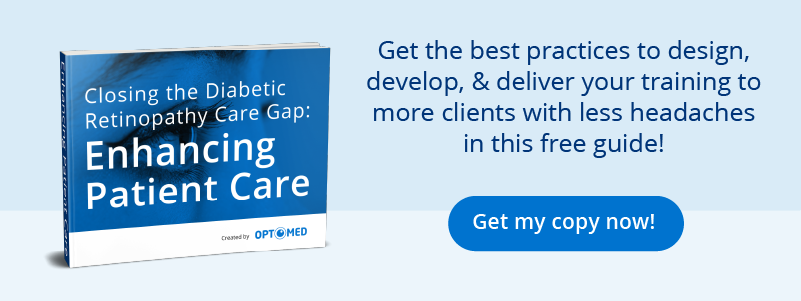Diabetic Retinopathy: A Major Public Health Issue
In 2017, there were an estimated 425 million diabetics, aged twenty to seventy-nine, on the planet. One-third of these individuals showed some sign of diabetic retinopathy, with one in ten experiencing vision loss. Diabetic retinopathy is the leading cause of preventable vision loss in this age group. Decades of research have shown that 90% of vision loss caused by diabetic retinopathy can be prevented with timely screenings with an eye scanner and proper treatment. So, why haven’t we stopped it yet?
Why Haven’t We Stopped Diabetic Retinopathy?
Although vision loss from diabetic retinopathy is highly preventable when screened and treated in a timely manner, there is a significant lack of screening compliance. Only about 55% of diabetics in the US receive retinopathy screenings, and the percentages are even lower in low- and middle-income countries worldwide. The three main reasons that diabetic retinopathy screening rates are so low have been identified as the high cost of testing, insufficient health care facilities, and limited access to screening.
Fortunately, as technology advances, so do alternatives to expensive screening options. Teleophthalmology has been gaining popularity for years due to its low cost and accessibility.
Business Implications
Twenty years ago, it would have been financially impractical, if not downright impossible, for a primary care practice to purchase an eye scanner and offer diabetic retinopathy screenings right from the office. Traditional tabletop fundus cameras are expensive and bulky and require highly trained technicians. However, with handheld mobile fundus cameras, such as Optomed’s Aurora, it’s not only possible, but it also just makes good business sense. The initial investment is modest, and there are no infrastructure costs with mobile cameras. Optomed’s eye scanners are easy to learn, so there is little staff time lost to training. With Medicare reimbursements for diabetic retinopathy screenings, many primary care physician (PCP) offices find that they can quickly recoup their initial investment and enjoy a previously untapped small revenue stream.
More valuable than the revenue is the peace of mind that comes with knowing that you’re doing all that you can to preserve your patients’ sight. You’re reducing the risk of missing something significant and keeping abreast of best practices as they evolve with changing technology over time.
Making Screening Viable in Varied Situations and across Diverse Communities
A 2020 systematic review and meta-analysis scrutinized thirty-three articles on the diagnostic accuracy of telescreening for diabetic retinopathy, as well as twenty-eight articles on its cost-effectiveness. The authors concluded that telescreening is an accurate and cost-effective method of screening for signs of diabetic retinopathy. Teleretinal screenings can decrease clinic workload and increase patient compliance with recommended screenings, especially in rural or lower socioeconomic patients. Furthermore, these patients were more likely to have signs of diabetic retinopathy detected when screened than their higher-socioeconomic counterparts. Accordingly, the authors concluded that teleretinal screenings can prevent blindness in a significant portion of the vulnerable diabetic population.
In addition to enhancing access to screenings in rural or other underserved areas, mobile non-mydriatic fundoscopy has definite potential in several other settings, as noted in the June 2018 report from the American Academy of Ophthalmology (AAO). Emergency departments, nursing homes, private residences, and remote areas are among the various situations that could benefit from mobile eye scanner technology. But the AAO article focuses primarily on smartphone-based fundoscopy and discusses its limitations, such as a lack of FDA approval, suboptimal image quality, cumbersome practices to comply with HIPAA regulations, and a considerable learning curve to master the art.
The handheld mobile fundus camera has all the benefits of mobile fundoscopy and none of the drawbacks.
The Benefits of Handheld Mobile Fundus Cameras
The benefits of handheld mobile fundus cameras include an affordable price point, exceptional portability, and ease of use. Research shows that with minimal initial training and moderate practice, non-eye-care specialists, including paraprofessional staff, can produce high-quality images suitable to rule out or confirm the presence of signs of diabetic retinopathy.
As handheld mobile fundus camera technology continues to evolve, image quality and intelligence features also continue to improve. For example, Optomed’s newest iteration, the Aurora, has autofocus, auto exposure, and high-contrast optical design to ensure high-quality imaging. Its 50-degree field of vision is optimal for detecting signs of diabetic retinopathy. Because it is non-mydriatic, it can easily be worked into an existing PCP appointment quickly, without waiting for eye dilation and without patients worrying about light sensitivity or driving home afterward. The Aurora is also designed for secure, HIPAA-compliant cloud connectivity, with seamless integration into existing electronic health record systems. It is FDA cleared in the US and is approved as a medical device in Canada, Europe, and other key markets worldwide.
Physicians Can Use a Mobile Eye Scanner to Prevent Diabetic Retinopathy-Related Blindness
In increasing numbers, physicians are joining the movement to save the sight of millions of vulnerable diabetics worldwide, starting with the patients in their own neighborhood. By incorporating eye screenings for diabetic retinopathy into their practice using a portable Optomed handheld fundus camera, the goal of protecting patients’ vision on a significant scale becomes highly attainable.
Here at Optomed, our mission is to help save the vision of millions of people. By integrating our software and artificial intelligence solutions with our camera, we enable eye screening for everyone, wherever they are. To see how we can equip you to save the sight of more patients, schedule a free consultation today!



